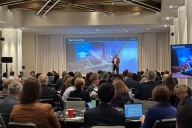You have /5 articles left.
Sign up for a free account or log in.
I need to add a hearty "hear hear" to Alan Levine's recent call to "flip the conference."
I'm writing this post from the Austin-Bergstrom International Airport, heading back to Eugene, Oregon (which according to my driver's license, at least, is "home") after 2+ weeks of 4 straight back-to-back conferences: O'Reilly Strata, DML, SXSWedu, and SXSW Interactive.
I'm exhausted. And as I've been telling people for at least the past four days or so, I'm "over it." So take my feelings about conferences right now with a grain of salt. Or, alternately, take my argument for a flipped conference as the wave of the future. You never know how these things work out in ed-tech, after all.
"Flipping the classroom" has become one of the most popular and pervasive buzz-phrases in ed-tech lately, thanks no doubt to the superstar status achieved by Sal Khan who argues that educators should assign his videos for homework and be free then to spend their in-class time on personal remediation and the like. Those who know that video-based instruction wasn't actually invented by the former hedge fund analyst are probably apt to point out that the notion of the "flip" pre-dates Khan. Daniel Pink called it the Fisch Flip back in 2010, when he examined the videos that Colorado math teacher Karl Fisch had created for his classes. The idea was the same though: assign the videos as homework; do exercises together in class.
As Levine argues -- and oh man, do I agree -- "Why cannot we do this for conferences? All of that content stuff that we fill up the agenda with -- presentations, videos, talks -- can be done before the event, and we can use the bulk fo the time for the stuff that counts -- discussion, debates, conversations -– in fact, I’d like to go to a conference where we get to do something, make something, instead of talking about doing things, or showing pictures of people making something."
Lots of folks have asked me what the best thing I've seen at SXSW is. The thing is, there wasn't a "thing." I saw people, lots of people that I spend time with online, offline. (I got to meet Levine himself, so there's that). But when our shared interests drew us to panel discussions and keynotes together, I felt that our time together just wasn't well spent. We were restricted by the format of the conference: the speaker presents for 40-45 minutes then opens things up to Q&A. Then, inevitably, someone who's not on the panel uses a good 5-8 minutes of that time to deliver a mini-presentation of their own -- often tangential, rarely conducive to more discussion. Super frustrating.
Add to that the fact that most sessions at most events are videotaped or recorded or tweeted in some manner, then the incentive to attend becomes less and less. Indeed, I plan to spend the weekend watching the videos of all the keynotes I didn't attend at SXSW (which was all of them).
So, I say, assign us the videos of your presentations in advance. Whether it's a keynote or a panel, you can record these things prior to the conference. Then, when we are all in the room together, we can talk and build and share, rather than just sit and listen.





